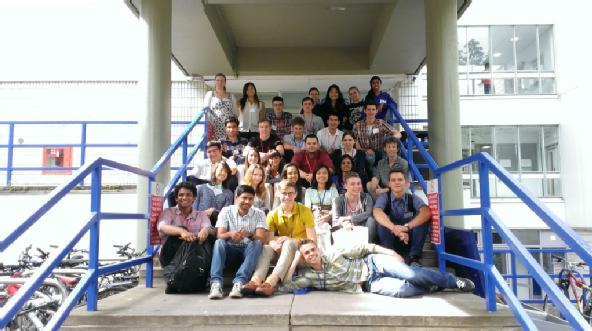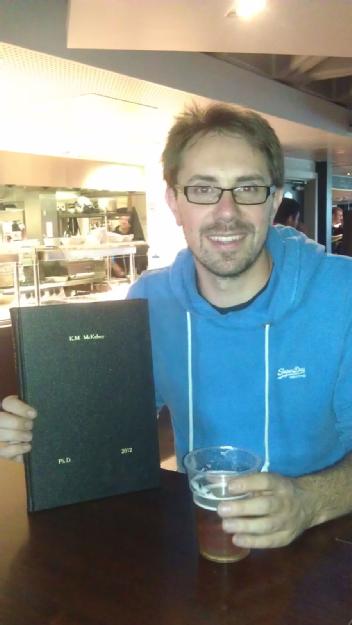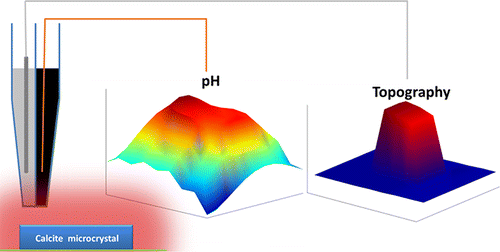News
Carbon in Electrochemistry - Faraday Discussion
The most recent Faraday Discussion 172 was held in Sheffield from the 28-30 July 2014. This discussions main focus was on the use of Carbon materials in electrochemistry applications. Topics included graphene, carbon nanotubes and carbon at the nanoscale; diamond and sp3 carbons in electrochemistry; carbon electrodes in electrochemical energy technology; and understanding and controlling the carbon interface.

Above: Guohui Zhang, Prof. Patrick Unwin, Prof. Richard McCreery, Dr. Aleix Guell
Several members of the Warwick electrochemisty and Interfaces Group were in attendance including Prof. Patrick Unwin, Prof. Julie Macpherson, Dr. Aleix Guell, Guohui Zhang and Lingcong Meng. Professor Patrick Unwin was an invited speaker at the discussion, and the paper co-authored by Dr Aleix Guell was a main topic of discussion - "Mapping Nanoscale Electrochemistry of Individual Single-Walled Carbon Nanotubes". PhD students Lingcong Meng and Guohui Zhang both presented posters on their latest research.
WEIG hosts LIYSF 2014
Once again, the Warwick Electrochemistry and Interfaces Group hosted 23 young enthusiastic international students participating in the annual 'London International Youth Science Forum' (LIYSF)![]()
 . LIYSF is a two week residential event held at Imperial College London, with lectures and demonstrations from leading scientists, visits to industrial sites, research centres, scientific institutions and organisations, including world class laboratories and universities. LIYSF attracts over 350 of the world's leading young scientists aged 17-21 years old from more than 60 participating countries. There is an active social calendar with events designed to enable those from around the world to learn about different cultures. The scope of LIYSF extends further than broadening scientific understanding to engage students in education on other cultures and develop lasting, international friendships.
. LIYSF is a two week residential event held at Imperial College London, with lectures and demonstrations from leading scientists, visits to industrial sites, research centres, scientific institutions and organisations, including world class laboratories and universities. LIYSF attracts over 350 of the world's leading young scientists aged 17-21 years old from more than 60 participating countries. There is an active social calendar with events designed to enable those from around the world to learn about different cultures. The scope of LIYSF extends further than broadening scientific understanding to engage students in education on other cultures and develop lasting, international friendships.
The students enjoyed a day full of hands-on activities, giving them a glimpse of the cutting-edge research at the electrochemistry and interfaces group.

This year, LIYSF’s underlying theme is ‘Eureka - Breakthrough and Development in Science’, focussing on exploring the way that we as scientists develop novel solutions and approaches to important challenges.
Small groups of students investigated structural and electrochemical properties of in-house grown carbon nanotube network (CNT), prepared by Sharel. The students got hands-on experience with electrochemical techniques, atomic force microscopy (AFM) and scanning electron microscopy (SEM). They also got to build dye sensitized solar cell (DSSC) devices, measure their performance and realize how closely related they are to photosynthesis! Most important was the interaction between the young visitors and group members who both hugely inspired each other, talking over lunch. We were extremely impressed with the questions asked by the students in attendance.
Big thanks must go to Barak Aaronson and Binoy Paulose Nadappuram for organising the event, and for everyone else involved (Faduma Maddar, Sharel Pei, Maria Adobes-Vidal, Minkyung Kang, Sze-yin Tan, Alexander Parker and Zoë Ayres.
We have hosted the LIYSF for each of the past 11 years and look forward to further visits in the future!
The 65th Diamond Conference
Warwick University hosted the annual Diamond Conference sponsored by De Beers, celebrating the landmark of 65 years. The conference ran from thre 7th to the 10th of July with delegates attending from all over the globe. Lectures covered a wide variety of different diamond research areas including electrochemical applications, nanodiamond, gemmology, quantum technologies, CVD growth, as well as diamond devices and applications.

Several members of the research group presented posters about their diamond research including Jennifer Webb on her investigation into the use of diamond nanopores, Tania Read on her diamond pH generation ring-disk electrode, Lingcong Meng on laser-heated diamond electrochemistry, as well as Glen O'Neil and Zoë Ayres on their work on Electrochemical x-ray fluoresence. Jonathan Newland also gave a well-received talk on "Diamond Microfluidic Devices for Electrochemical Analysis".
The conference provided an opportunity for members of the group to meet researchers and industrialists in the diamond community.
Departmental Doctoral Thesis Award Winner
Many congratulations to Kim McKelvey who has been awarded with the Faculty of Science Doctoral Thesis Award for his work on " New Approaches and Application in Electrochemical Scanning Probe Microscopy".

The initiative, which was commissioned by the Faculty of Science, offered awards of up to £500 for the best PhD theses from each of the Faculty of Science PhD-awarding departments and centres.
Supervisors were invited to nominate eligible students. Each department onvened a panel of internal and external academics to review the nominations and choose the successful candidate.
We also want to take this opportunity to wish Kim all the best in his next academic venture as a postdoctoral fellow in Indiana, USA at the University of Notre Dame in the Timp Nano-Bio Group.
Paper makes Analytical Chemistry top 10
The top 10 most popular spectroscopy and material science papers published in Analytical Chemistry throughout the last year have been listed in the recent issue of Chemical and Engineering News Magazine.
Among the top 10 was work conducted by members at WEIG, Binoy Nadappuram, Kim McKelvey, Rehab al Botros, Alex Colburn and Pat Unwin on the "Fabrication and Characterization of Dual Function Nanoscale pH-Scanning Ion Conductance Microscopy (SICM) Probes for High Resolution pH Mapping".

The work features the quantitative power of dual function SICM probes to monitor pH as well as topographical changes during the dissolution of a calcite crystal. Congratulations to all those involved!
